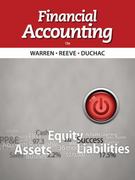Question
61.Sampling risk refers to the possibility that: Group of answer choices The confidence level and/or precision established by the auditor are not appropriate. The auditor
61.Sampling risk refers to the possibility that:
Group of answer choices
The confidence level and/or precision established by the auditor are not appropriate.
The auditor may use a less than optimal statistical method for the circumstances, e.g. difference estimation instead of ratio estimation.
The auditor may fail to recognize an error that exists in the sample.
Even though a sample is properly chosen, it may not be representative of the population.
62.One way to reduce sampling risk is to
Group of answer choices
use an appropriate method of selecting sample items from the population.
carefully design the audit procedures to be used.
use variables sampling rather than attributes sampling.
provide proper supervision and instructions to the audit team.
63.The acceptable risk of assessing control risk too low in relation to the sample size is
Group of answer choices
parallel.
inverse.
not defined.
direct.
64.Select the description which illustrates sampling risk.
Group of answer choices
Applying audit procedures which are inappropriate for the audit objectives.
Choosing a sample which has proportionately more errors than the population.
Arriving at incorrect statistical conclusions due to computational errors.
Failing to recognize errors or deviations in the documents examined.
65.One of the causes of non-sampling error is the:
Group of answer choices
failure to draw a representative sample.
use of inappropriate or ineffective audit procedures.
use of attributes sampling instead of variables sampling.
failure to draw a random sample.
66. When an auditor does a sampling for attributes, which of the following would decrease sample size?
| Risk of assessing control risk too low | Tolerable rate of Deviation | Expected population deviation rate | |
| A. | Increase | Decrease | Increase |
| B. | Decrease | Increase | Decrease |
| C. | Increase | Increase | Decrease |
| D. | Increase | Increase | Increase |
Group of answer choices
Choice C
Choice B
Choice A
Choice D
67.Which of the following factors is generally not considered in determining the sample size for a test of controls?
Group of answer choices
Risk of assessing control risk too low
Tolerable rate
Population size
Expected population deviation rate
68.When the auditor goes through a population and selects items for the sample without regard to their size, source, or other distinguishing characteristics, it is called
Group of answer choices
systematic selection.
statistical selection.
block selection.
haphazard selection.
69.Statistical samples as compared to non-statistical samples permit the auditor to
Group of answer choices
eliminate any type of non-sampling errors.
quantify and control sampling risk.
obtain smaller sample sizes in all cases.
use less complex formulas than those required to evaluate non-statistical samples.
70.Of the following statements, which one best differentiates statistical sampling from non-statistical sampling?
Group of answer choices
Statistical sampling is a mathematical approach to inference, whereas non-statistical sampling is a more subjective approach.
Non-statistical sampling has greater applicability to populations that lend themselves to random selection.
Non-statistical sampling has greater applicability to large populations than does statistical sampling.
Non-statistical sampling is more subjective, but produces greater consistency in the application of audit judgment.
Step by Step Solution
There are 3 Steps involved in it
Step: 1

Get Instant Access to Expert-Tailored Solutions
See step-by-step solutions with expert insights and AI powered tools for academic success
Step: 2

Step: 3

Ace Your Homework with AI
Get the answers you need in no time with our AI-driven, step-by-step assistance
Get Started


